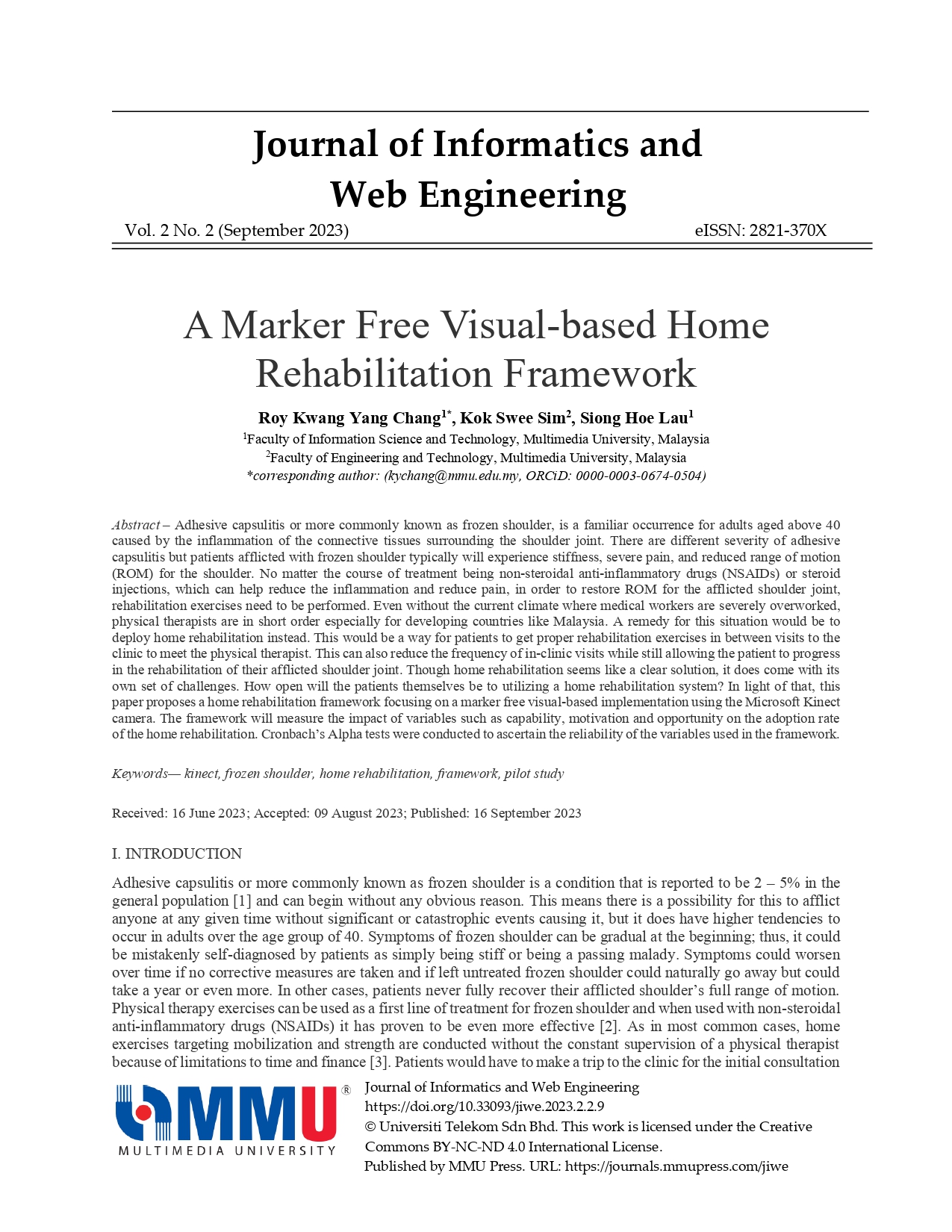A Marker Free Visual-based Home Rehabilitation Framework
Main Article Content
Abstract
Adhesive capsulitis or more commonly known as frozen shoulder, is a familiar occurrence for adults aged above 40 caused by the inflammation of the connective tissues surrounding the shoulder joint. There are different severity of adhesive capsulitis but patients afflicted with frozen shoulder typically will experience stiffness, severe pain, and reduced range of motion (ROM) for the shoulder. No matter the course of treatment being non-steroidal anti-inflammatory drugs (NSAIDs) or steroid injections, which can help reduce the inflammation and reduce pain, in order to restore ROM for the afflicted shoulder joint, rehabilitation exercises need to be performed. Even without the current climate where medical workers are severely overworked, physical therapists are in short order especially for developing countries like Malaysia. A remedy for this situation would be to deploy home rehabilitation instead. This would be a way for patients to get proper rehabilitation exercises in between visits to the clinic to meet the physical therapist. This can also reduce the frequency of in-clinic visits while still allowing the patient to progress in the rehabilitation of their afflicted shoulder joint. Though home rehabilitation seems like a clear solution, it does come with its own set of challenges. How open will the patients themselves be to utilizing a home rehabilitation system? In light of that, this paper proposes a home rehabilitation framework focusing on a marker free visual-based implementation using the Microsoft Kinect camera. The framework will measure the impact of variables such as capability, motivation and opportunity on the adoption rate of the home rehabilitation. Cronbach’s Alpha tests were conducted to ascertain the reliability of the variables used in the framework.
Article Details

This work is licensed under a Creative Commons Attribution-NonCommercial-NoDerivatives 4.0 International License.
All articles published in JIWE are licensed under a Creative Commons Attribution-NonCommercial-NoDerivatives 4.0 International (CC BY-NC-ND 4.0) License. Readers are allowed to
- Share — copy and redistribute the material in any medium or format under the following conditions:
- Attribution — You must give appropriate credit, provide a link to the license, and indicate if changes were made. You may do so in any reasonable manner, but not in any way that suggests the licensor endorses you or your use;
- NonCommercial — You may not use the material for commercial purposes;
- NoDerivatives — If you remix, transform, or build upon the material, you may not distribute the modified material.
References
M. J. Kelley, M. A. Shaffer, J. E. Kuhn, L. A. Michener, A. L. Seitz, T. L. Uhl, J. J. Godges, P. McClure, "Shoulder Pain and Mobility Deficits: Adhesive Capsulitis," Journal of Orthopaedic & Sports Physical Therapy, vol. 43, no. 5, 2013.
H. B. Y. Chan, P. K. Pua, C. H. How, "Physical therapy in the management of frozen shoulder," Singapore Medical Journal, vol. 58, no. 12, pp. 685-689, 2017.
T. Stutz, M. Domhardt, G. Emsenhuber, D. Huber, M. Tiefengrabner, N. Matis and S. Ginzinger, "An Interactive 3D Health App with Multimodal Information Representation for Frozen Shoulder: Co-Creation and Evaluation with Patients", Proceedings of the 19th International Conference on Human-Computer Interaction with Mobile Devices and Services, Vienna, Austria, Article No. 3, pp. 1–11, 2017.
E. M. Sluijs, G. J. Kok, J. V. D. Zee, "Correlates of exercise compliance in physical therapy", Physical therapy, vol. 73, no. 11, pp. 771-786, 1993.
M. Faber, M. H. Andersen, C. Sevel, K. Thorborg, T. Bandholm, M. Rathleff, "The majority are not performing home-exercises correctly two weeks after their initial instruction-an assessor-blinded study", PeerJ, vol. 3, 2015. http://dx.doi.org/10.7717/peerj.1102.
M. Too and R. Chang, “A Fundamental Study of an Alternative Learning Framework Utilizing Natural User Interface (NUI) for Physically Disabled Students,” International Journal on Robotics, Automation and Sciences, vol. 5, no. 1, pp. 1-5, 2023.
H. Seo, J. Kim, K. Seo, B. Kim, J. Noh, "Overthere : A Simple and Intuitive Object Registration Method for an Absolute Mid-air Pointing Interface", Proceedings of the ACM Interactive, Mobile, Wearable Ubiquitous Technology, vol. 5, no. 3, 2021.
R. K. Y. Chang, K. S. Sim, S. H. Lau, M. S. M. Too, "Assessing Agreement between Kinect and Goniometer: A Feasibility Study in Melaka", ISAAC 2018, Seoul, Korea, pp. 13-18, 2018.
S. H. Lee, C. Yoon, S. G. Chung, H. C. Kim, Y. Kwak, H. Park, K. Kim, “Measurement of shoulder range of motion in patients with adhesive capsulities using a Kinect”, PLoS ONE, vol. 10, 2015.
S.J. Hardcastle, C. Maxwell-Smith, M. S. Hagger, "Predicting physical activity change in cancer survivors: an application of the Health Action Process Approach," Journal of Cancer Survivorship, 2021. https://doi.org/10.1007/s11764-021-01107-6.
C. Zhang, X. Zheng, H. Huang, C. Su, H. Zhao, H. Yang, Y. Guo and X. Pan, "A Study on the Applicability of the Health Action Process Approach to the Dietary Behavior of University Students in Shanxi, China," Journal of Nutrition Education and Behavior, vol. 50, no. 4, pp. 388-395, 2018.
S. B. Ore, L. L. Rodriguez, "TAM: A Reference Model for Mobile Cash Adoption", Proceedings of the 7th International Conference on Information Communication and Management, Moscow, Russian Federation, pp. 148-152, 2017.
N. D. P. Emrinaldi and M. Irfan, "ERP-Based Accounting Information System Implementation in Organization: A Study in Riau, Indonesia," The Journal of Asian Finance, Economics, and Business, vol. 7, no. 12, pp. 147-157, 2020.
M. Andarwati, D. Zuhroh, F. Amrullah, "End User Satisfaction of Accounting Information System (AIS) Mobile Based for Small Medium Enterprises (SMEs): Actual Usage and TAM Approach," Journal of Development Research, vol. 3, no. 2, pp. 37-42, 2019.
J. Castner, "Changing Behaviors: The Behavior Change Wheel and Emergency Nursing," Journal of Emergency Nursing, vol. 47, no. 5, pp. 678-683, 2021.
L. Sorensen, M. V. Tulder, H. V. Johannsen, "Responsiveness and minimal important change of the Oxford Shoulder Score, EQ-5D, and the Fear-Avoidance Belief Questionnaire Physical Activity subscale in patients undergoing arthroscopic subacromial decompression", JSES International, vol. 5, no. 5, pp. 869-874, 2021.
M. Tavakol and R. Dennick, "Making sense of Cronbach's alpha," International journal of medical education, vol. 2, pp. 53-55, 2011.

